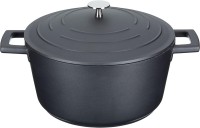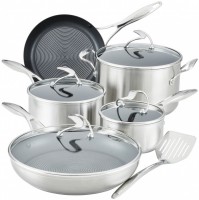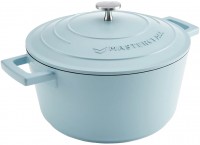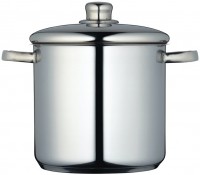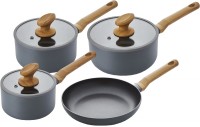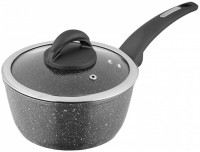Stockpots Lamart
All Stockpots Advanced filters → |
You might be interested in
Stockpots: specifications, types
Type
- Pot. This category includes the classic type of pans: vessels with great depth and a pair of small loop handles on the sides. With rare exceptions, they have a round shape, the volume (see below) can be very diverse. Classic pans are intended mainly for cooking and stewing in the traditional way, over an open fire or in the oven (however, the latter largely depends on the material of the handle and the non-stick coating, see the corresponding paragraphs).
- Ladle. A type of pan, the main distinguishing feature of which is a long handle (instead of the classic paired loop handles). In some cases, it is more convenient to operate such utensils; in addition, long handles do not heat up as quickly as short ones. On the other hand, the handles of ladles are less able to bear heavy weight, and therefore pans of this type usually have a relatively small volume; and it can be difficult to use them in the oven.
- Pressure cooker. A type of pan equipped with a special cover. Such a cover is able to close hermetically, which ensures increased steam pressure and temperature inside the cookware. Due to this, the cooking speed increases significantly (hence the name). In addition, due to the closed structure, food does not oxidize when exposed to air, which is why pressure cookers are considered optimal for vegetables. However, this type of pan will be very useful in cooking other products, especially when it comes to “long-lasting” dishes like jellied meat. Another advantage provided by the closed nature is ease of use: pressure cookers do not create splashes or stains during the cooking process and do not make the kitchen stuffy, because all the steam is inside. On the other hand, using such utensils requires some caution: the cover must not be opened until the pressure inside has dropped to a safe level. Usually a special valve is provided to release steam; many models are also equipped with emergency valves that prevent critical pressure increases. If necessary, the pressure cooker can also be used as a classic saucepan - just do not close the cover latches or take another cover, not airtight, but suitable in size.
— Steamer. True to their name, these pans are designed for steaming dishes. A classic steamer consists of a main container in which water is heated to create steam, and one or more “add-ons” on which food is placed during the cooking process. The bottoms of such superstructures are made of a special mesh or have small holes for the passage of steam. Technically, using some tricks, you can steam in a regular saucepan (see above), but using a specialized steamer for this is still much more convenient and simpler. In addition, in many models of this type, the main container is quite deep and can, if necessary, be used as a regular saucepan.
- Pasta cooker. Utensils intended for preparing pasta - pasta. It is somewhat reminiscent of a double boiler, consisting of two items: the main one is the pan itself, and the second is a container with holes both at the bottom and on the sides, or just a mesh basket. The pasta cooker allows the pasta to always be in water and after cooking you just need to remove the top element of the structure. The water will drain on its own and there will be no need for a colander.
- Kokotnitsa. Structurally, such pans are similar to ladles (see above), but have a very small capacity - usually about 100-150 ml. They are intended for preparing julienne and other similar dishes, most often by baking. Cocotte makers are poorly suited for other purposes, but they can be indispensable as serving utensils.
- Milkman. Containers designed, as the name suggests, for heating and boiling milk. The design of milk jugs is usually selected in such a way as to avoid “escaping” the contents; Some models have double walls and can be used for steam bath cooking. The volume of such dishes can vary: the smallest milk jugs hold about 0.25 - 0.5 liters and are designed to heat 1 - 2 servings of milk (or milk added to coffee), the largest vessels hold more than 2 liters. However, all milk jugs are distinguished by their “elongated” proportions - their height is noticeably greater than their diameter.
— Juice cooker. Specially designed saucepans designed for extracting juice from vegetables and fruits. In fact, the juice cooker consists of three “floors”: water is poured into the bottom container, the middle one is designed to collect the resulting juice, and the top one is a colander where vegetables and fruits are placed. Heating is carried out by steam generated in the lower container, and the container for the finished juice has a drain tube. Juice cookers are similar in purpose to juicers, but have a number of advantages over them. Firstly, in such a container you can prepare not only juices, but also jams, marmalades, jellies, etc. Secondly, the resulting product can be immediately sealed in jars; it does not need to be sterilized. Thirdly, juice from a juicer can be stored for a long time in a regular refrigerator, while juice from a juicer is best drunk immediately. The disadvantages of this method include the long cooking time.
- Set of dishes. A set consisting of several pans. The pots themselves can be of the same type or different, and even include other types of utensils (for example, a frying pan, see “Contents”), which gives quite a wide range of possibilities for choosing a set for specific needs. The set can be useful if you need to purchase several pans at the same time (for example, when completing a kitchen from scratch). Firstly, you will get everything you need in one go, without the hassle of searching and purchasing each individual item, and secondly, many manufacturers set prices in such a way that sets are cheaper than the same items purchased separately.
- Ladle. A type of pan, the main distinguishing feature of which is a long handle (instead of the classic paired loop handles). In some cases, it is more convenient to operate such utensils; in addition, long handles do not heat up as quickly as short ones. On the other hand, the handles of ladles are less able to bear heavy weight, and therefore pans of this type usually have a relatively small volume; and it can be difficult to use them in the oven.
- Pressure cooker. A type of pan equipped with a special cover. Such a cover is able to close hermetically, which ensures increased steam pressure and temperature inside the cookware. Due to this, the cooking speed increases significantly (hence the name). In addition, due to the closed structure, food does not oxidize when exposed to air, which is why pressure cookers are considered optimal for vegetables. However, this type of pan will be very useful in cooking other products, especially when it comes to “long-lasting” dishes like jellied meat. Another advantage provided by the closed nature is ease of use: pressure cookers do not create splashes or stains during the cooking process and do not make the kitchen stuffy, because all the steam is inside. On the other hand, using such utensils requires some caution: the cover must not be opened until the pressure inside has dropped to a safe level. Usually a special valve is provided to release steam; many models are also equipped with emergency valves that prevent critical pressure increases. If necessary, the pressure cooker can also be used as a classic saucepan - just do not close the cover latches or take another cover, not airtight, but suitable in size.
— Steamer. True to their name, these pans are designed for steaming dishes. A classic steamer consists of a main container in which water is heated to create steam, and one or more “add-ons” on which food is placed during the cooking process. The bottoms of such superstructures are made of a special mesh or have small holes for the passage of steam. Technically, using some tricks, you can steam in a regular saucepan (see above), but using a specialized steamer for this is still much more convenient and simpler. In addition, in many models of this type, the main container is quite deep and can, if necessary, be used as a regular saucepan.
- Pasta cooker. Utensils intended for preparing pasta - pasta. It is somewhat reminiscent of a double boiler, consisting of two items: the main one is the pan itself, and the second is a container with holes both at the bottom and on the sides, or just a mesh basket. The pasta cooker allows the pasta to always be in water and after cooking you just need to remove the top element of the structure. The water will drain on its own and there will be no need for a colander.
- Kokotnitsa. Structurally, such pans are similar to ladles (see above), but have a very small capacity - usually about 100-150 ml. They are intended for preparing julienne and other similar dishes, most often by baking. Cocotte makers are poorly suited for other purposes, but they can be indispensable as serving utensils.
- Milkman. Containers designed, as the name suggests, for heating and boiling milk. The design of milk jugs is usually selected in such a way as to avoid “escaping” the contents; Some models have double walls and can be used for steam bath cooking. The volume of such dishes can vary: the smallest milk jugs hold about 0.25 - 0.5 liters and are designed to heat 1 - 2 servings of milk (or milk added to coffee), the largest vessels hold more than 2 liters. However, all milk jugs are distinguished by their “elongated” proportions - their height is noticeably greater than their diameter.
— Juice cooker. Specially designed saucepans designed for extracting juice from vegetables and fruits. In fact, the juice cooker consists of three “floors”: water is poured into the bottom container, the middle one is designed to collect the resulting juice, and the top one is a colander where vegetables and fruits are placed. Heating is carried out by steam generated in the lower container, and the container for the finished juice has a drain tube. Juice cookers are similar in purpose to juicers, but have a number of advantages over them. Firstly, in such a container you can prepare not only juices, but also jams, marmalades, jellies, etc. Secondly, the resulting product can be immediately sealed in jars; it does not need to be sterilized. Thirdly, juice from a juicer can be stored for a long time in a regular refrigerator, while juice from a juicer is best drunk immediately. The disadvantages of this method include the long cooking time.
- Set of dishes. A set consisting of several pans. The pots themselves can be of the same type or different, and even include other types of utensils (for example, a frying pan, see “Contents”), which gives quite a wide range of possibilities for choosing a set for specific needs. The set can be useful if you need to purchase several pans at the same time (for example, when completing a kitchen from scratch). Firstly, you will get everything you need in one go, without the hassle of searching and purchasing each individual item, and secondly, many manufacturers set prices in such a way that sets are cheaper than the same items purchased separately.
Main items
Number of main items included in the package. This parameter can be specified both for cookware sets and for steamers/ juice cookers(for both, see “Type”). In the first case, the main items are considered to be the cooking vessels themselves - pots, pans, etc.; lids and additional accessories such as stands are not included in the calculation. For steamers, the number of items means the number of...tiers provided in the design - including the lowest one, into which water is poured.
Size
The size of a pan is indicated by its diameter ( for round pans) or width ( for square pans). For sets containing objects of different sizes, values for all objects are given in this paragraph.
The volume of the pan directly depends on the size (see below). At the same time, it is also determined by depth; In fact, this means that dishes with the same capacity can vary in size. In such cases, when choosing, it is wor...th considering that a wider pan heats up faster and more evenly, but requires a larger burner. Actually, the size of the pan should not be less than the size of the burner; this is especially important if you plan to use the dishes on an electric stove.
The smallest pans, sold individually, are 16 cm or less in size, in the largest this figure can exceed 25 cm. As for sets, their sizes can be quite varied: in the smallest sets, the diameter of the largest pan is less than 20 cm(although other types of dishes can be larger), in the largest sets, the size is the same 20 cm(or even more) has the smallest pan.
The volume of the pan directly depends on the size (see below). At the same time, it is also determined by depth; In fact, this means that dishes with the same capacity can vary in size. In such cases, when choosing, it is wor...th considering that a wider pan heats up faster and more evenly, but requires a larger burner. Actually, the size of the pan should not be less than the size of the burner; this is especially important if you plan to use the dishes on an electric stove.
The smallest pans, sold individually, are 16 cm or less in size, in the largest this figure can exceed 25 cm. As for sets, their sizes can be quite varied: in the smallest sets, the diameter of the largest pan is less than 20 cm(although other types of dishes can be larger), in the largest sets, the size is the same 20 cm(or even more) has the smallest pan.
Bottom diameter
This parameter is used in order to evaluate the compatibility of the pan with a particular burner on the stove. It acquires particular importance if the product is planned to be used on an electric stove: the diameter of the burner must be at least not less than the diameter of the bottom, otherwise the heating will turn out to be uneven and inefficient. And in induction electric stoves, these diameters must match at all. The selection of suitable pans is somewhat simplified by the fact that mod...ern stoves and hobs usually have burners of different diameters, and in some models, the heaters can even be adjusted in size — up to autofocus in individual induction instances. However, even in cases like this, it doesn't hurt to clarify whether the pan fits into the range of suitable sizes.
Volume
Working volume (capacity) of the pan. For sets (see "Type"), which include dishes of different sizes, values are given in this paragraph for all items.
A large volume allows you to cook a large amount of product at a time, but it affects the dimensions and weight of the pan. Therefore, the optimal capacity for different cases will also be different — depending on the amount of cooking and the type of dish. So, for classic pots, 3 – 4 L is considered...a universal option: in such dishes it is convenient to cook soups and compotes for an average family. Models with a capacity of 2 – 3 liters are also popular — they are convenient for cooking side dishes, as well as small amounts of cooking (for 1 – 2 people). The smallest pans have a volume of less than 1 liter, they are suitable, in particular, for boiling eggs and heating milk. And the largest ones contain more than 10 liters, such dishes are designed mainly for catering and public events.
There are also more detailed recommendations on the choice of volume, including for other types of dishes — ladles, milk jugs, etc. (see "Type"); these recommendations can be found in special sources.
A large volume allows you to cook a large amount of product at a time, but it affects the dimensions and weight of the pan. Therefore, the optimal capacity for different cases will also be different — depending on the amount of cooking and the type of dish. So, for classic pots, 3 – 4 L is considered...a universal option: in such dishes it is convenient to cook soups and compotes for an average family. Models with a capacity of 2 – 3 liters are also popular — they are convenient for cooking side dishes, as well as small amounts of cooking (for 1 – 2 people). The smallest pans have a volume of less than 1 liter, they are suitable, in particular, for boiling eggs and heating milk. And the largest ones contain more than 10 liters, such dishes are designed mainly for catering and public events.
There are also more detailed recommendations on the choice of volume, including for other types of dishes — ladles, milk jugs, etc. (see "Type"); these recommendations can be found in special sources.
Depth
The nominal depth of the pot. In most cases, it is a secondary parameter: the manufacturer selects the depth in accordance with the type, size and volume of dishes, and when choosing, you should first of all focus on these characteristics (for more details, see above).


